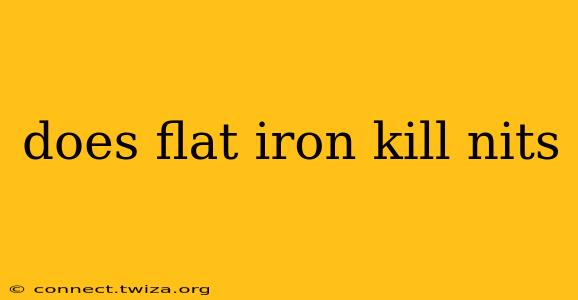Head lice infestations are a common, albeit unpleasant, experience for many families. While various methods exist to eliminate these pesky parasites, one question frequently arises: does a flat iron kill nits? The short answer is yes, but it's not the most effective or recommended method. Let's delve deeper into why.
How Effective is a Flat Iron at Killing Nits?
High heat, like that produced by a flat iron, can indeed kill nits. The heat denatures the proteins in the nit, effectively killing the insect inside. However, there are significant drawbacks to using a flat iron for this purpose.
The Challenges:
- Precision is Crucial: Nits are incredibly small and are tightly attached to the hair shaft. It's extremely difficult to ensure every single nit receives the necessary heat to kill it. Missing even a few can lead to re-infestation.
- Risk of Hair Damage: Applying a hot flat iron directly to the hair, especially repeatedly, can cause significant damage, leading to breakage, dryness, and even burns. This is especially true for fine or already damaged hair.
- Time-Consuming and Tedious: Thoroughly examining and treating every strand of hair with a flat iron is a painstakingly slow process. This makes it impractical for most people.
- Ineffective Against Lice: While the high heat kills nits (the eggs), it's not effective against adult lice. You still need to address the live lice to effectively eliminate the infestation.
What are the Best Ways to Get Rid of Nits?
While a flat iron might kill some nits, it's not a reliable or safe method for complete lice removal. Here are the most effective strategies:
1. Nit Combing:
This involves using a fine-toothed nit comb to physically remove both nits and lice from the hair. This method requires patience and thoroughness, but it's highly effective when done correctly. Wetting the hair and using a conditioner can help to loosen the nits.
2. Medicated Lice Shampoos and Lotions:
Many over-the-counter and prescription medications are available to kill lice. These typically contain permethrin or pyrethrin, which are insecticides. Always follow the product instructions carefully.
3. Home Remedies (Use with Caution):
Some home remedies, such as tea tree oil or mayonnaise, are touted as effective lice treatments. However, their effectiveness is not consistently proven, and they may not be suitable for everyone. Always consult with a doctor or dermatologist before trying any home remedy.
Are there any other ways to get rid of lice?
Yes! Beyond the main methods, here are some additional points to consider:
Vacuuming:
Thoroughly vacuuming carpets, furniture, and bedding can help remove any lice or nits that have fallen off the hair.
Washing Bedding and Clothing:
Wash all bedding, towels, and clothing in hot water (at least 130°F) and dry them on high heat for at least 30 minutes to kill any remaining lice or nits.
Professional Lice Removal Services:
If you're struggling to eliminate the infestation yourself, consider seeking professional help. Lice removal services are available and can provide expert assistance.
What Happens if I Don't Get Rid of Nits?
Leaving nits untreated can lead to a persistent infestation. The nits will hatch into lice, continuing the cycle of infestation and spreading to others.
Conclusion:
While a flat iron can kill nits, it's not a practical or recommended method for lice removal. The risk of hair damage, the time involved, and the fact it doesn't address live lice make other methods far more efficient and safer. For effective lice treatment, focus on nit combing, medicated treatments, and thorough cleaning of your environment. Always consult a doctor or dermatologist if you have concerns or persistent infestations.
